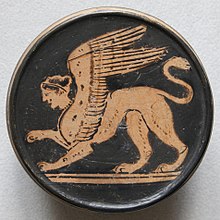Sphinx
 Attic red-figure pyxis, 2nd half of the 5th century BC. From Nola (Italy). | |
| Grouping | Legendary creatures |
|---|---|
| Similar entities | Griffin, Manticore, Cherub, Lamassu, Narasimha |
| Region | Persian, Egyptian and Greek |
A sphinx (Boeotian: φίξ [pʰíːks], plural sphinxes or sphinges) is a mythical creature with the head of a human, the body of a lion, and the wings of an eagle.
In ancient Greek mythology, this is a monster with the head of a woman, the front feet and body of a lion, the wings of an eagle, and the tail of a bull. This is an evil creature. It kills people and then eats them.[1] This is the character of the legend of Oedipus.[2]
In Egyptian mythology, the sphinx is usually a kind creature, but it has same power as in the Greek version. Both Greek and Egyptian sphinxes guard something, and statues of sphinxes stand near the doors to palaces.[3]
During the Renaissance in Europe, people made the sphinx in different ways. This was because people had translated the description of the sphinx into Renaissance languages differently. However, pictures of the sphinx are usually associated with the Egyptian Sphinx.
Name[change | change source]
The word sphinx comes from the Greek word Σφίγξ, meaning "compress", "pull up" because this is how lions kill the animals that they eat. However, the historian Susan Wise Bauer suggests that the word "sphinx" was instead a Greek corruption of the Egyptian name "shesepankh".[4]
Indian culture also has pictures of lion-men. Some palaces are decorated with lion-men.
Egypt[change | change source]

A sphinx dates back to the Old Kingdom of Egypt, and its name comes from the Ancient Greek name for a "stranger". The Sphinx is also common in South and South-East Asia, and was popular in Europe from the times of the Renaissance. The Sphinx was famous for riddles. It was used to protect the pyramids of Giza. Giza has ahead of a man and the body of a lion. One notable sphinx appears in the legend of Oedipus and killed travellers who failed to correctly answer a riddle about the three ages of man ("Which creature has one voice, but travels on four legs in the morning, two in the afternoon and three in the evening?"). Oedipus correctly solved it ("Man-he crawls on all fours as a baby, in adulthood, he walks upright, and in old age, he walks with a cane").
References[change | change source]
- ↑ "Dr. J's Lecture on Oedipus and the Sphinx". People.hsc.edu. Retrieved 15 May 2014.
- ↑ Kallich, Martin. "Oedipus and the Sphinx." Oedipus: Myth and Drama. N.p.: Western, 1968. N. pag. Print.
- ↑ Stewart, Desmond. Pyramids and the Sphinx. [S.l.]: Newsweek, U.S., 72. Print.
- ↑ Bauer, S. Wise (2007). The History of the Ancient World. New York, NY: W. W. Norton & Company, Inc. pp. 110–112. ISBN 978-0-393-05974-8.
